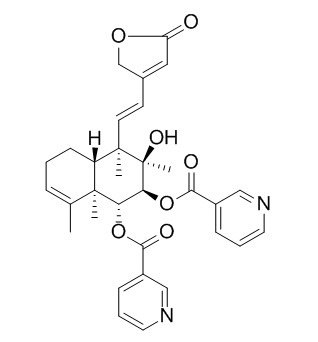Scutebarbatine A
Scutebarbatine A shows significant antitumor effects on A549 cells in vivo and in vitro via mitochondria-mediated apoptosis by up-regulating expressions of caspase-3 and 9, and down-regulating Bcl-2. Scutebarbatine A and barbatine A show a significant ability to protect cells against H2O2 with ED50 values of 5.0 and 16.8 uM, respectively.
Inquire / Order:
manager@chemfaces.com
Technical Inquiries:
service@chemfaces.com
Tel:
+86-27-84237783
Fax:
+86-27-84254680
Address:
1 Building, No. 83, CheCheng Rd., Wuhan Economic and Technological Development Zone, Wuhan, Hubei 430056, PRC
Providing storage is as stated on the product vial and the vial is kept tightly sealed, the product can be stored for up to
24 months(2-8C).
Wherever possible, you should prepare and use solutions on the same day. However, if you need to make up stock solutions in advance, we recommend that you store the solution as aliquots in tightly sealed vials at -20C. Generally, these will be useable for up to two weeks. Before use, and prior to opening the vial we recommend that you allow your product to equilibrate to room temperature for at least 1 hour.
Need more advice on solubility, usage and handling? Please email to: service@chemfaces.com
The packaging of the product may have turned upside down during transportation, resulting in the natural compounds adhering to the neck or cap of the vial. take the vial out of its packaging and gently shake to let the compounds fall to the bottom of the vial. for liquid products, centrifuge at 200-500 RPM to gather the liquid at the bottom of the vial. try to avoid loss or contamination during handling.
Nutrients.2024, 16(19):3266.
Indian Journal of Science and Technology2023, 16(SP1):48-56.
Plant Methods.2017, 13:108
Phytochemistry Letters2017, 449-455
Nutrients.2018, 11(1):E17
Molecules.2020, 25(18),4089.
Molecules.2020 ,25(16):3697.
Mol Immunol. 2016, 78:121-132
Revista Brasileira de Farmacognosia2024, 34:1276-1286.
Arch Pharm Res.2015, 38(6):1080-9
Related and Featured Products
Molecules. 2014 Jun 25;19(7):8740-51.
In vitro and in vivo antitumor activity of scutebarbatine A on human lung carcinoma A549 cell lines.[Pubmed:
24968330]
During our systematic study on the anticancer activities of Scutellaria barbata, Scutebarbatine A (SBT-A), one of the major alkaloids in S. barbata, was found to have antitumor effects on A549 cells. Thus, we designed the present study to investigate in detail the antitumor effects of Scutebarbatine A .
METHODS AND RESULTS:
The cytotoxic effect of Scutebarbatine A on A549 in vitro were determined by an MTT assay and evaluated by IC50 values. Furthermore, results of Hoechst 33258 and Annexin V/PI staining assays demonstrated that Scutebarbatine A had significant antitumor effects on A549 cells via apoptosis, in a concentration-dependent manner. What's more, the mechanism was explored by western blotting, and our study revealed that Scutebarbatine A can up-regulate the expressions of cytochrome c, caspase-3 and 9, and down-regulate the levels of Bcl-2 in A549 cells. Finally, the antitumor effects of Scutebarbatine A were evaluated in vivo by using transplanted tumor nude mice, and the results confirmed that Scutebarbatine A has a notable antitumor effect on A549 cancer via mitochondria-mediated apoptosis.
CONCLUSIONS:
Collectively, our results demonstrated that Scutebarbatine A showed significant antitumor effects on A549 cells in vivo and in vitro via mitochondria-mediated apoptosis by up-regulating expressions of caspase-3 and 9, and down-regulating Bcl-2.
Oxid Med Cell Longev . 2015;2015:843721.
Ginsenoside Rb1 Treatment Attenuates Pulmonary Inflammatory Cytokine Release and Tissue Injury following Intestinal Ischemia Reperfusion Injury in Mice[Pubmed:
26161243]
Abstract
Objective. Intestinal ischemia reperfusion (II/R) injury plays a critical role in remote organ dysfunction, such as lung injury, which is associated with nuclear factor erythroid 2-related factor 2 (Nrf2)/heme oxygenase-1 (HO-1) signaling pathway. In the present study, we tested whether ginsenoside Rb1 attenuated II/R induced lung injury by Nrf2/HO-1 pathway. Methods. II/R injury was induced in male C57BL/6J mice by 45 min of superior mesenteric artery (SMA) occlusion followed by 2 hours of reperfusion. Ginsenoside Rb1 was administrated prior to reperfusion with or without ATRA (all-transretinoic acid, the inhibitor of Nrf2/ARE signaling pathway) administration before II/R. Results. II/R induced lung histological injury, which is accompanied with increased levels of malondialdehyde (MDA), interleukin- (IL-) 6, and tumor necrosis factor- (TNF-) α but decreased levels of superoxide dismutase (SOD) and IL-10 in the lung tissues. Ginsenoside Rb1 reduced lung histological injury and the levels of TNF-α and MDA, as well as wet/dry weight ratio. Interestingly, the increased Nrf2 and HO-1 expression induced by II/R in the lung tissues was promoted by ginsenoside Rb1 treatment. All these changes could be inhibited or prevented by ATRA. Conclusion. Ginsenoside Rb1 is capable of ameliorating II/R induced lung injuries by activating Nrf2/HO-1 pathway.
Eur. J. Org. Chem., 2009, 2009(33): 5810-5.
Novel Antioxidant neo-Clerodane Diterpenoids from Scutellaria barbata.[Reference:
WebLink]
METHODS AND RESULTS:
Four new neo-clerodane diterpenoids, barbatines A–D (1–4), have been isolated from the whole plant of Scutellariabarbata (Lamiaceae), along with the known Scutebarbatine A (5), and their structures determined by spectral analysis, including mass spectrometry and 2D NMR spectroscopy. The absolute configurations of 2 and 5 were established from their CD spectra by using the exciton chirality rule. A biogenetic pathway for these compounds is proposed based on their structures.
CONCLUSIONS:
Barbatine A (1) and Scutebarbatine A (5) showed a significant ability to protect cells against H2O2 with ED50 values of 16.8 and 5.0 μM, respectively.



